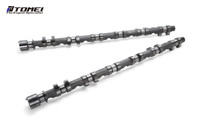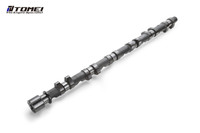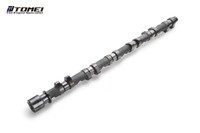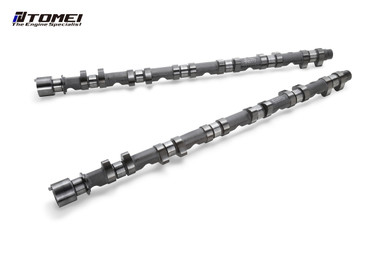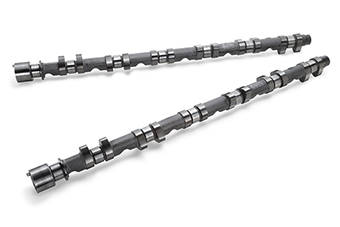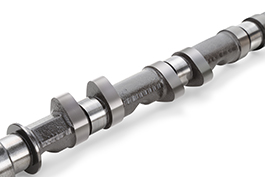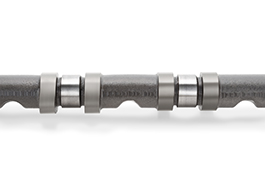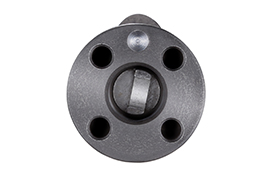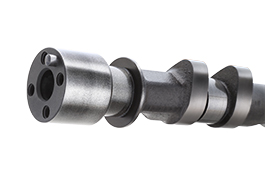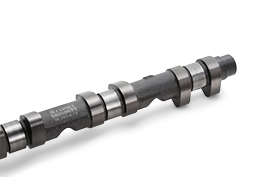*Sold as a set of 2 (IN and EX)
Single P/N :
INTAKE - TA301C-NS05A
EXHAUST - TA301E-NS05A
Stock valve spring compatible & stock valve lifter compatible
| - |
 |
| |
 |
NISSAN RB26DETT CAMSHAFT |
 |
|
|
 |
| |
|
|
|
 |
■ Pre-set valve timing |
| ■ Works best with 'bolt-on' type turbos |
| ■ Stable idle |
| ■ Compatible with stock valve springs |
| ■ Noticable, linear gains in performance |
|
|
|
|
| ''VALC' profile features- Velocity, Acceleration, Lift, Control |
|
 |
| ■Optimized 'velocity' and 'acceleration'. |
| ■Designed for high power setups. |
| ■Optimizes engine performance. |
| ■Higher lift than other profiles of the duration. |
| ■Reduced stress/wear on the valve train. |
| |
 |
 |
 |
| The VALC profile allows the valves to open faster and for longer. This translates to faster lift and increased area under the 'lift curve' (see fig. ①) |
| which in turn generates more power. (Greater area under the 'lift curve' = greater air intake) |
|
| ① |
|
|
 |
|
 |
・CAM ACCELERATION:LOW
・LIFT:LOW
・AIR INTAKE:LOW |
|
・CAM ACCELERATION:HIGH
・LIFT:HIGH
・AIR INTAKE:HIGH |
|
|
|
|
|
|
|
|
 |
 |
| Unlike the valve opening, the VALC profile ensures that the valves close at a slower rate, helping to prevent common valve train related issues. |
|
|
|
 |
 |
With a conventional direct-acting valve train, the maximum lift is usually determined by the size/diameter of the valve lifter. Selecting a high-lift camshaft without taking this into consideration often results in the camshaft lobes travelling beyond the surface of the valve lifter. This causes the lobe to make contact with the edge of the lifter, damaging both components over time. (see fig. ②)
Therefore, the ideal performance orientated high-lift camshaft needs to have a profile that maximizes lobe travel on the lifter without exceeding the outer edge.
VALC profile camshafts have achieved this ideal by deliberately reducing the maximum cam velocity to limit lobe travel on the lifter surface. (Maximum cam velocity = lobe travel distance on lifter) |
|
|
| ② |
 |
| High lift profile without taking lifter size/radius into account. |
|
|
 |
| Compared to standard profile camshafts of the same lift, VALC profile camshafts are able to then then off-set the difference for even greater lift/performance gains. |
 |
| Conventional profile based on lifter size/radius. |
|
 |
| 'VALC' profile. |
|
 |
| ''VALC' profile + additional lift. |
|
 |
| Lift comparison between a conventional profile and 'VALC' profile. |
|
|
 |
Conventional profile |
|
 |
'VALC' profile |
|
 |
'VALC' profile + additional lift. |
|
|
 |
|
|
 |
|
|
| Machining each lobe to the strictest tolerances allows for smoother and more precise adjustments in valve clearances. |
| Based on: 9.15mm max lift, Φ32 base circle |
| SPEC. |
41.15mm |
| ACTUAL (avg.) |
41.1455mm |
| DIFFERENCE (avg.) |
0.0045mm |
| DIFFERENCE (%) |
0.0001% |
|
|
| The greater this 'difference', the more shims and time required to adjust the valve clearance. |
|
 |
|
| |
|
|
 |
| Lobe nose interrelationship (front view) |
| Strict phase angle tolerances minimizes the risk of valve timing issues and ensures each valve opens and closes precisely. |
| SPEC. |
See above |
| DIFFERENCE (avg.) |
0°4′41″(0.078°) |
| DIFFERENCE (%) |
0.0026% |
|
|
| Our research showed that some camshafts from other manufacturers had more than 5 degrees difference in the phase angle! This makes it near impossible to achieve the correct valve timing. |
|
|
|
| |
|
|
 |
|
|
 |
|
|
| |
|
|
|
|
|
|
 |
|
|
|
|
 Loading... Please wait...
Loading... Please wait...


